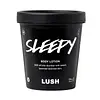What's inside
What's inside
 Key Ingredients
Key Ingredients

 Benefits
Benefits

 Concerns
Concerns

 Ingredients Side-by-side
Ingredients Side-by-side

Avena Sativa Kernel Extract
AbrasiveMilk
Skin ConditioningPrunus Amygdalus Dulcis Oil
Skin ConditioningLavandula Angustifolia Flower Water
Skin ConditioningLavandula Angustifolia Flower
Skin ConditioningSimmondsia Chinensis Seed Oil
EmollientGlycerin
HumectantTheobroma Cacao Seed Butter
EmollientStearic Acid
CleansingIllipe Butter
Skin ConditioningTriethanolamine
BufferingLavandula Angustifolia Oil
MaskingStyrax Benzoin Gum
MaskingDipteryx Odorata Seed Extract
MaskingViola Odorata Oil
MaskingCetearyl Alcohol
EmollientBenzyl Benzoate
AntimicrobialBenzyl Cinnamate
PerfumingCoumarin
PerfumingGeraniol
PerfumingLimonene
PerfumingLinalool
PerfumingParfum
MaskingSynthetic Fluorphlogopite
Titanium Dioxide
Cosmetic ColorantTin Oxide
AbrasiveCI 45380
Cosmetic ColorantBlue 1 Lake
Cosmetic ColorantAvena Sativa Kernel Extract, Milk, Prunus Amygdalus Dulcis Oil, Lavandula Angustifolia Flower Water, Lavandula Angustifolia Flower, Simmondsia Chinensis Seed Oil, Glycerin, Theobroma Cacao Seed Butter, Stearic Acid, Illipe Butter, Triethanolamine, Lavandula Angustifolia Oil, Styrax Benzoin Gum, Dipteryx Odorata Seed Extract, Viola Odorata Oil, Cetearyl Alcohol, Benzyl Benzoate, Benzyl Cinnamate, Coumarin, Geraniol, Limonene, Linalool, Parfum, Synthetic Fluorphlogopite, Titanium Dioxide, Tin Oxide, CI 45380, Blue 1 Lake
Sodium Bicarbonate
AbrasiveCitric Acid
BufferingParfum
MaskingGlycine Max Seed Extract
Skin ConditioningJasminum Grandiflorum Flower Cera
Skin ConditioningSalvia Sclarea Oil
MaskingCananga Odorata Flower Oil
MaskingWater
Skin ConditioningTitanium Dioxide
Cosmetic ColorantHexamethylindanopyran
MaskingPropylene Glycol
HumectantGeraniol
PerfumingLimonene
PerfumingLinalool
PerfumingAlpha-Isomethyl Ionone
PerfumingCI 17200
Cosmetic ColorantCI 42090
Cosmetic ColorantCI 14700
Cosmetic ColorantCI 45410
Cosmetic ColorantOzothamnus Diosmifolius Extract
Sodium Bicarbonate, Citric Acid, Parfum, Glycine Max Seed Extract, Jasminum Grandiflorum Flower Cera, Salvia Sclarea Oil, Cananga Odorata Flower Oil, Water, Titanium Dioxide, Hexamethylindanopyran, Propylene Glycol, Geraniol, Limonene, Linalool, Alpha-Isomethyl Ionone, CI 17200, CI 42090, CI 14700, CI 45410, Ozothamnus Diosmifolius Extract
Ingredients Explained
These ingredients are found in both products.
Ingredients higher up in an ingredient list are typically present in a larger amount.
Geraniol is used to add fragrance/parfum to a product. It is the main component of citronellol. It is a monoterpenoid and an alcohol.
Monoterpenes are naturally found in many parts of different plants.
Geraniol can be found in many essential oils including Rose Oil and Citronella Oil. The scent of Geraniol is often described as "rose-like". Many foods also contain Geraniol for fruit flavoring.
Geraniol can irritate the skin when exposed to air. However, irritation depends on the ability of geraniol to penetrate into the skin. In general, geraniol is not able to penetrate skin easily.
Geraniol is colorless and has low water-solubility. However, it is soluble in common organic solvents.
Like citronellol, it is a natural insect repellent.
2,6-Octadien-1-ol, 3,7-dimethyl-, (2E)-
Learn more about GeraniolLimonene is a fragrance that adds scent and taste to a formulation.
It's found in the peel oil of citrus fruits and other plants such as lavender and eucalyptus. The scent of limonene is generally described as "sweet citrus".
Limonene acts as an antioxidant, meaning it helps neutralize free radicals.
When exposed to air, oxidized limonene may sensitize the skin. Because of this, limonene is often avoided by people with sensitive skin.
The term 'fragrance' is not regulated in many countries. In many cases, it is up to the brand to define this term. For instance, many brands choose to label themselves as "fragrance-free" because they are not using synthetic fragrances. However, their products may still contain ingredients such as essential oils that are considered a fragrance.
Learn more about LimoneneLinalool is a fragrance and helps add scent to products. It's derived from common plants such as cinnamon, mint, citrus, and lavender.
Like Limonene, this ingredient oxidizes when exposed to air. Oxidized linalool can cause allergies and skin sensitivity.
This ingredient has a scent that is floral, spicy tropical, and citrus-like.
Learn more about LinaloolParfum is a catch-all term for an ingredient or more that is used to give a scent to products.
Also called "fragrance", this ingredient can be a blend of hundreds of chemicals or plant oils. This means every product with "fragrance" or "parfum" in the ingredients list is a different mixture.
For instance, Habanolide is a proprietary trade name for a specific aroma chemical. When used as a fragrance ingredient in cosmetics, most aroma chemicals fall under the broad labeling category of “FRAGRANCE” or “PARFUM” according to EU and US regulations.
The term 'parfum' or 'fragrance' is not regulated in many countries. In many cases, it is up to the brand to define this term.
For instance, many brands choose to label themselves as "fragrance-free" because they are not using synthetic fragrances. However, their products may still contain ingredients such as essential oils that are considered a fragrance by INCI standards.
One example is Calendula flower extract. Calendula is an essential oil that still imparts a scent or 'fragrance'.
Depending on the blend, the ingredients in the mixture can cause allergies and sensitivities on the skin. Some ingredients that are known EU allergens include linalool and citronellol.
Parfum can also be used to mask or cover an unpleasant scent.
The bottom line is: not all fragrances/parfum/ingredients are created equally. If you are worried about fragrances, we recommend taking a closer look at an ingredient. And of course, we always recommend speaking with a professional.
Learn more about ParfumTitanium dioxide is a mineral UV filter widely used in sunscreens and cosmetics.
It is one of only two UV filters officially classified as “mineral” by regulatory agencies, the other being zinc oxide.
Titanium dioxide provides broad-spectrum protection mostly in the UVB and UVAII range, with some protection in the UVAI range.
While its UVA protection isn’t as strong as zinc oxide’s, the difference is minor.
A common myth is that mineral UV filters reflect UV light. However, modern research shows titanium dioxide absorbs UV radiation like chemical filters (~95% absorption & 5% reflection).
Thanks to its non-irritating nature, titanium dioxide is suitable for sensitive, acne-prone, or redness-prone skin. It is unlikely to cause "eye sting" like other sunscreen ingredients.
A major drawback of this ingredient is its white cast and thick texture. This is why mineral sunscreens often leave a white cast and are less cosmetically elegant than chemical/hybrid sunscreens.
To improve white cast and spreadability, micronized or nano-sized titanium dioxide is often used.
There are ongoing concerns surrounding nano-titanium oxide's impact on marine ecosystems.
There is no conclusive evidence that any form of titanium oxide (or any other sunscreen ingredients) will cause harm to marine ecosystems or coral reefs. The science is still developing but many consumers are keeping a close eye on this issue.
Please note, many destinations have reef-safety sunscreen rules. For instance, the U.S. Virgin Islands advises all visitors to use non-nano mineral sunscreens.
Nano mineral sunscreens once raised safety concerns about absorption into skin.
Extensive research has shown that they do not penetrate healthy or damaged skin; they remain safely on the surface and the top layer of dead skin (stratum corneum).
You'll likely find titanium dioxide bundled with alumina, silica, or dimethicone. These ingredients help make titanium dioxide highly photostable; this prevents it from interacting with other formula components under UV light.
Learn more about Titanium Dioxide